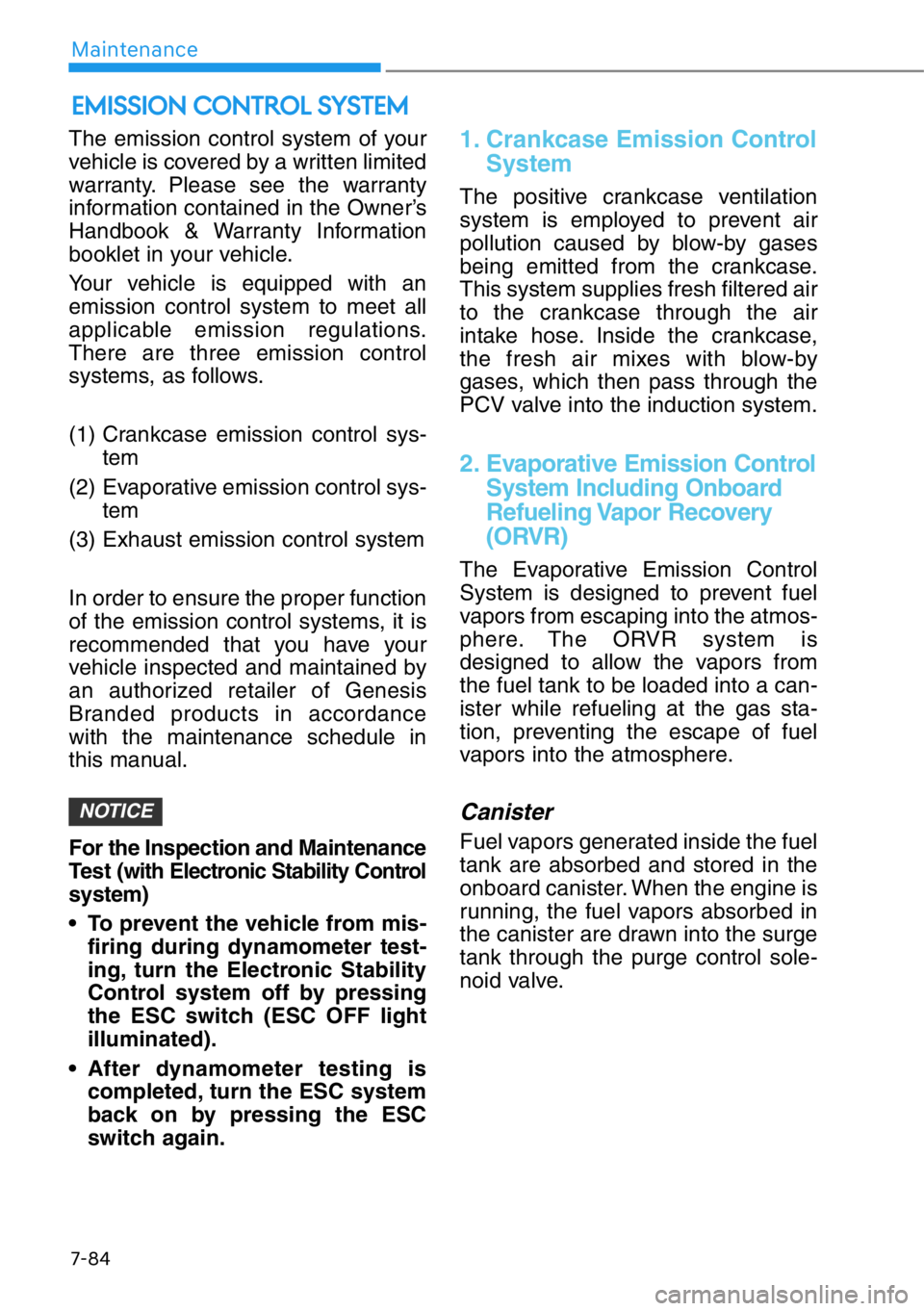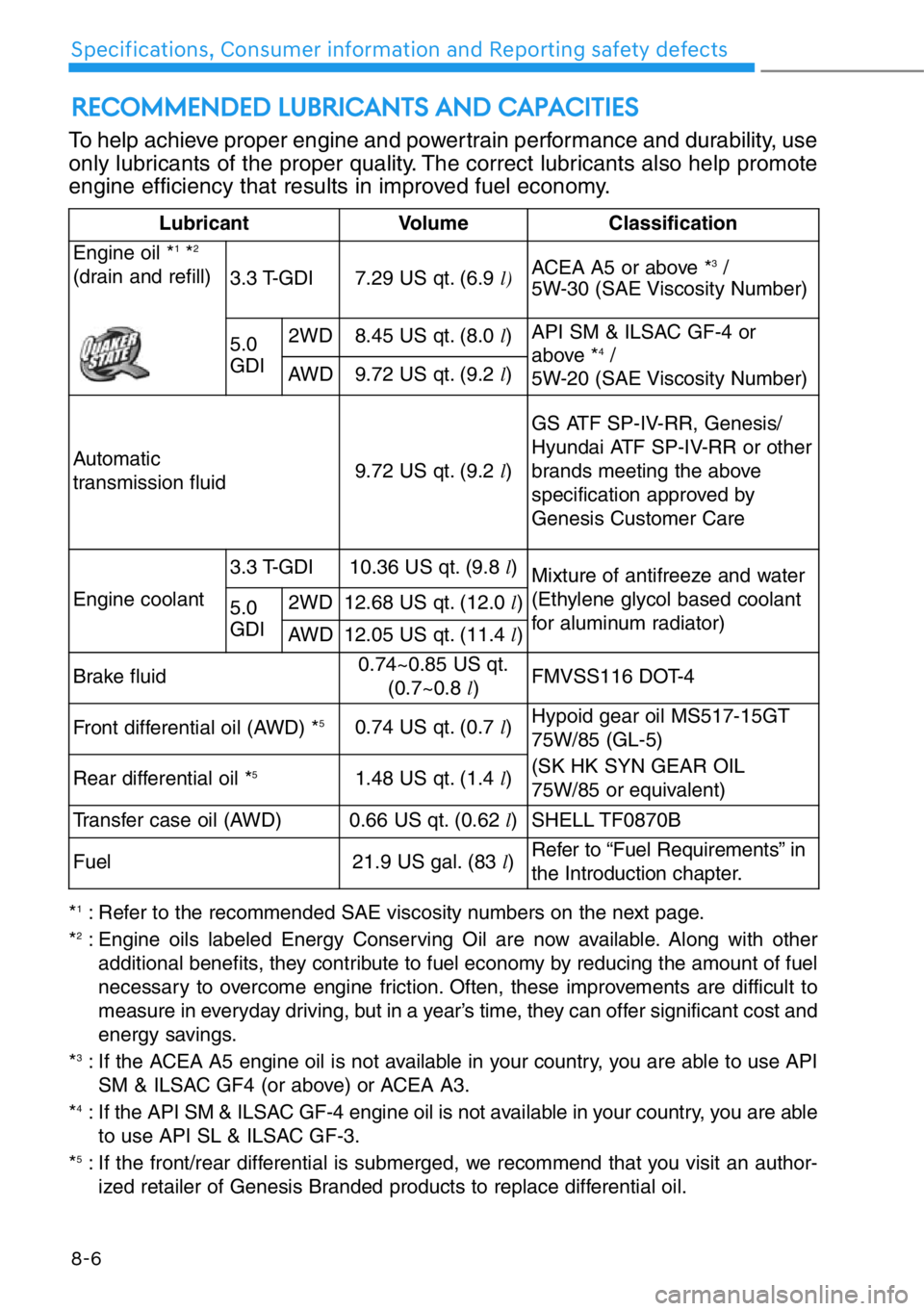fuel cap HYUNDAI GENESIS G90 2019 User Guide
[x] Cancel search | Manufacturer: HYUNDAI, Model Year: 2019, Model line: GENESIS G90, Model: HYUNDAI GENESIS G90 2019Pages: 538, PDF Size: 13.02 MB
Page 524 of 538

7-84
Maintenance
The emission control system of your
vehicle is covered by a written limited
warranty. Please see the warranty
information contained in the Owner’s
Handbook & Warranty Information
booklet in your vehicle.
Your vehicle is equipped with an
emission control system to meet all
applicable emission regulations.
There are three emission control
systems, as follows.
(1) Crankcase emission control sys-
tem
(2) Evaporative emission control sys-
tem
(3) Exhaust emission control system
In order to ensure the proper function
of the emission control systems, it is
recommended that you have your
vehicle inspected and maintained by
an authorized retailer of Genesis
Branded products in accordance
with the maintenance schedule in
this manual.
For the Inspection and Maintenance
Test (
with Electronic Stability Control
system)
• To prevent the vehicle from mis-
firing during dynamometer test-
ing, turn the Electronic Stability
Control system off by pressing
the ESC switch (ESC OFF light
illuminated).
• After dynamometer testing is
completed, turn the ESC system
back on by pressing the ESC
switch again.
1. Crankcase Emission Control
System
The positive crankcase ventilation
system is employed to prevent air
pollution caused by blow-by gases
being emitted from the crankcase.
This system supplies fresh filtered air
to the crankcase through the air
intake hose. Inside the crankcase,
the fresh air mixes with blow-by
gases, which then pass through the
PCV valve into the induction system.
2. Evaporative Emission Control
System Including Onboard
Refueling Vapor Recovery
(ORVR)
The Evaporative Emission Control
System is designed to prevent fuel
vapors from escaping into the atmos-
phere. The ORVR system is
designed to allow the vapors from
the fuel tank to be loaded into a can-
ister while refueling at the gas sta-
tion, preventing the escape of fuel
vapors into the atmosphere.
Canister
Fuel vapors generated inside the fuel
tank are absorbed and stored in the
onboard canister. When the engine is
running, the fuel vapors absorbed in
the canister are drawn into the surge
tank through the purge control sole-
noid valve.
NOTICE
EMISSION CONTROL SYSTEM
Page 533 of 538

To help achieve proper engine and powertrain performance and durability, use
only lubricants of the proper quality. The correct lubricants also help promote
engine efficiency that results in improved fuel economy.
RECOMMENDED LUBRICANTS AND CAPACITIES
8-6
Specifications, Consumer information and Reporting safety defects
Lubricant Volume Classification
Engine oil *
1*2
(drain and refill)
3.3 T-GDI7.29 US qt. (6.9 l)ACEA A5 or above *3/
5W-30 (SAE Viscosity Number)
5.0
GDI2WD8.45 US qt. (8.0 l)API SM & ILSAC GF-4 or
above *4/
5W-20 (SAE Viscosity Number)AWD9.72 US qt. (9.2 l)
Automatic
transmission fluid9.72 US qt. (9.2 l)GS ATF SP-IV-RR, Genesis/
Hyundai ATF SP-IV-RR or other
brands meeting the above
specification approved by
Genesis Customer Care
Engine coolant3.3 T-GDI10.36 US qt. (9.8l)
Mixture of antifreeze and water
(Ethylene glycol based coolant
for aluminum radiator)
5.0
GDI2WD12.68 US qt. (12.0 l)
AWD12.05 US qt. (11.4l)
Brake fluid0.74~0.85 US qt.
(0.7~0.8 l)FMVSS116 DOT-4
Front differential oil (AWD) *
50.74 US qt. (0.7 l)Hypoid gear oil MS517-15GT
75W/85 (GL-5)
(SK HK SYN GEAR OIL
75W/85 or equivalent) Rear differential oil *
51.48 US qt. (1.4 l)
Transfer case oil (AWD)0.66 US qt. (0.62 l)SHELL TF0870B
Fuel21.9 US gal. (83 l)Refer to “Fuel Requirements” in
the Introduction chapter.
*1: Refer to the recommended SAE viscosity numbers on the next page.
*2: Engine oils labeled Energy Conserving Oil are now available. Along with other
additional benefits, they contribute to fuel economy by reducing the amount of fuel
necessary to overcome engine friction. Often, these improvements are difficult to
measure in everyday driving, but in a year’s time, they can offer significant cost and
energy savings.
*
3: If the ACEA A5 engine oil is not available in your country, you are able to use API
SM & ILSAC GF4 (or above) or ACEA A3.
*
4: If the API SM & ILSAC GF-4 engine oil is not available in your country, you are able
to use API SL & ILSAC GF-3.
*
5: If the front/rear differential is submerged, we recommend that you visit an author-
ized retailer of Genesis Branded products to replace differential oil.